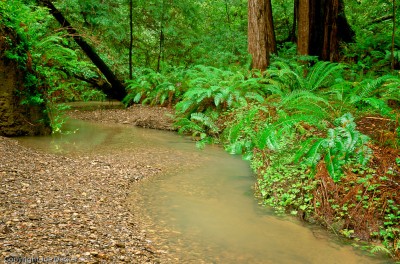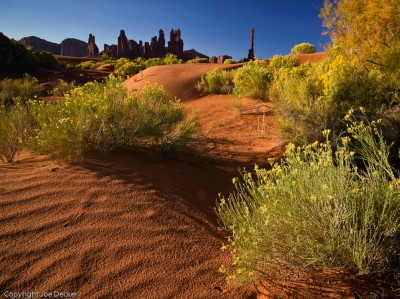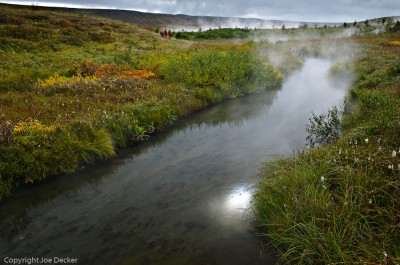If you like this article, you can now get the book! Joe has expanded the “Tuesday Composition” series into an inspiring new ebook on composition, especially for nature photography. Check it out: The Tuesday Composition.
We’ve talked about how the eye tends to follow along edges–and we’ve also talked a fair bit about the different ways that direction affects how that plays into composition. Today, I’m going to put those two concepts together, and more, as I talk about the venerable S-curve.
An S-curve is simply a curve of some object, line or path in the image that curves back and forth horizontally as you proceed vertically, much like the letter S–in fact, usually exactly like the letter S.
While applicable to any style of photography, one of the most common uses of the S-curve is in photographing the landscape–a stream, or perhaps a road zigzagging from the viewer back toward the horizon. Hot Stream, Husavik is a pretty direct example. Our eyes tend to flow from the camera to the horizon with the stream edges, combining three separate tropes that we’ve talked about before.
First, the eye tends to move along edges. Second, in this case, we start off moving left-to-right, which is likely to be your predominant reading direction (at least if you’re reading this post!). Finally, we move upward through the image, from near to far, an idea I briefly alluded to in my last post. We haven’t talked as much about lines emanating from corners (in fact, we’ll do that soon), but that’s in play here too.

I don’t really consciously tried to create S-curves in my composition, at least not often. As I’ve mentioned, a lot of these rules are almost something you observe, let sink in, and over time they just begin to inform your vision subconsciously. Because I don’t use “compositional rules” consciously when I shoot, I was pleased–and a little surprised–to find some evidence in my own body of work. In my portfolio, there are a number of S-curves, and significantly more of them seem to begin from the bottom-left than the bottom-right. It’s not that the S-curve won’t work the other way, but for whatever reason I’ve been more drawn to scenes in which the curve starts bottom-left.
Despite the fact that I notice a small difference in how often I prefer the from the bottom-left s-curves to the from the bottom-right s-curves, that difference is probably much closer to being an abstract curiosity than actionable advice.
Little Butano Creek looks great the way it’s presented–and maybe it’s just that I know the location–but when I try and flip the image horizontally it just doesn’t work as well for me. Perhaps the dark diagonal trunk (upper-left) first catches my eye, and in this case I travel down from there, rather than up from the camera.

You’ll also often find s-curves even where there isn’t such a direct line as the stream and stream edges here. In Red Morning Dunes, there’s an s-curve implied in the path–between the bushes we’d walk through if we were heading “into” the picture.
S-curves often seem to contribute a sense of depth to a landscape image. In both these examples, we see similar types of plants getting smaller and smaller as we wander back along the s-curve, giving our mind an easy opportunity to compare sizes and thus “see” the perspective and depth. In Red Morning Dunes, the way the plants overlap each as they form the boundaries of the s-curve also contributes to that sense of depth.
Next week, I’ll talk a little more about a related compositional ideas–diagonals and convergence. See you then!

Lorenzo Reffo
4 Sep 2009Very helpful post Joe, as usual! I’m impressed by the “Red Morning Dunes” shot, brilliant use of your tip! Incredible!
Joe Decker
4 Sep 2009Thanks, Lorenzo!